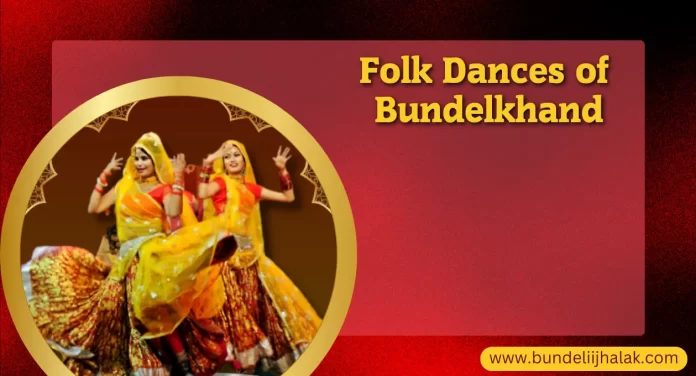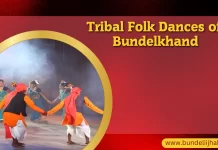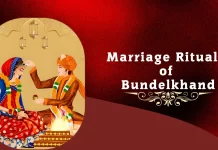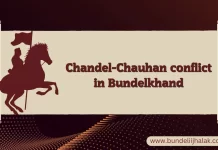Various folk dances are popular in Bundelkhand. Various types of songs are sung in Folk Dances of Bundelkhand. Popular folk dances in Bundelkhand are Badhai Dance, Baredi Dance, Holi Dance, Jawara Dance, Tribal Karma Dance, Saira Dance, Rawla, Rai Dance, Kanada Dance, Dhimaraai Dance, Naurata Dance etc. Folk dances of Bundelkhand are embedded in the folk life of Bundelkhand like life breath.
The main popular folk dances in Bundelkhand are as follows:- Badhai Dance, Baredi Dance, Holi Dance, Jawara Dance, Tribal Karma Dance, Saira Dance, Rawla, Rai Dance, Kanada Dance, Dhimaraai Dance, Naurata Dance etc. All these folk dances of Bundelkhand preserve the tradition of the state.
Each dance is associated with some tradition or custom. The costumes of these dances are coloured in the colour of Bundelkhand. The songs used in these dances are completely in the dialect of Bundelkhand. The rhythm of the songs of each dance is different and the rhythm of their songs is also different.
Badhaya Folk Dance
When the Badhaya is brought or the call is made, the women perform this folk dance collectively. The solo or group dance of the women on the tunes of Dhapla and Nagariya is at the peak of spontaneity and freedom. The dancing women wearing Lehenga and Nugro and a yellowish dupatta are skilled in captivating the mind with the magic of their fingers. There is an amazing coherence in the movements of the feet and the silent dance of the fingers, which is the soul of these folk dances.
When the rhythm of the instruments is fast or very fast, the lyrics of the folk song and the feet of the dancer or dancers accompanies them at the same speed. Sometimes the lyrics of a folk song get tired and fall silent, but the instruments keep playing on the rhythm of the song and the dance continues.
During the Chandel period, the festivals of Deepawali and Holi were celebrated. Festivals are joyous folk festivals, so the role of folk dances is important in them. As there is a festival, so is the folk dance suitable for it. There is no caste, class and sectarian discrimination in festivals, so there is no question of any prejudice in folk dances as well. They are free from every bias. The joy of festivals is purposeful and it is sure to be connected to some ideal. From this point of view, the same folk ideal is reflected in folk dances as well.
Mouniya Dance or Baredi Dance
Mouniya Dance is also known as Ahir or Baredi or Divari Dance. The difference is that Mouniya indicates a ritual, Divari indicates a festival, while Ahir or Baredi indicates caste and occupation. Thus this dance represents the emotions of ritual, occupation and festival.
This is a male dominated group dance, in which there is a group of at least 4-5 and not less than 10-15 people in total and it includes people from the age group of 8-10 years to the elderly of 55-60 years. They used to dance from the second day of Diwali to Kartik Purnima, but now the number of days has reduced considerably.
On the morning of the second day of Divari, the cowherds, Ahirs, shepherds, Yadavs etc. of the village take bath in the pond or river and wear their traditional dress. Those who observe a vow of silence are called Mouniyas. Red coloured Langiya (underwear) woven with white shiny cowrie shells and a jhumar studded with small bells adorn the waist, which is famous as ‘Langjhumar’.
A red coloured kurti or saluka on a healthy and well-built chest brings out a unique masculinity. Galgala (two rows of big bells) is tied on the jhumar. When they observe silence with a shield made of peacock feather handles and a weapon of two sticks in their hands, then even if people call them Mauniyas, they look like the embodiment of bravery.
Mauniyas wear dhoti up to the knees and a loose kurta and bandi on the chest and a turban or safa on the head. Many folk singers are ready with the resolve to sing Diwari songs. The third group is of folk musicians, the instruments used in traditional folk singing are Dhol, Nagdiya and Jhanjh and the Ramtula is a warning bell.
In other areas, they choose and use Mridang, Timki, Kasawari, Manjir, Dholak, Flute etc. as per their liking. First, when the beat of the Dhol is played with five-six Nagdiyas and Ramtula, people start dancing.
The Mouniya dance in a circular circle with only peacock feathers in their hands as per the sound of the instrument. In the beginning, the speed is slow, and the movements of the body are slow, but when the speed increases, the excellence of the art starts showing. Every nerve of the hands and thighs starts dancing and energy is generated by combining with the tinkling of the cowries and the movement of the tassels and then gradually the speed slows down and the dance comes to an end.
The second form is Danda Nritya or Chanchar, which is performed by the Mouniyas. Every dancer, while dancing, strikes his sticks with both his sticks to show his skill to his companions on either side, in front or behind, and then his art shines.
The third is the lathi dance, which is more popular in villages and is important from the viewpoint of exercise along with the skill of moves. All the methods of attacking or defending from attack are part of this dance. Actually, the Diwari or Baredi dance is a dithyrambic dance.
The tandavi posture of the dance is unique among all Indian folk dances. Another specialty is that this dance is a medium of connecting a village with twelve neighboring villages. Similarly, every village works with a ritual resolution for social and national unity and this role of its is a living example of serving the country.
Hori Dance
On the occasion of Holi, there is a tradition of performing Hori Dance in the moments of joy and happiness. This dance is mostly group. The youth dance separately in the fervor of Holi and women separately. The audience puts gulal and colors on the Holi dancers. The band of musicians accompanies them with folk instruments like Mridang or Dholak, Nagariya, Manjira, Jhinka etc.
As soon as the fourth part of Chaukadiya Phag ends, the dance starts on the rhythm of the instruments. Only Nagariya keeps playing and the dance continues. In Phagwars, some group calls a dancer, who dances separately and the group of dancers becomes her partner and imitates her and accompanies her.
Sometimes a bet is placed between the two, then the dance of both gets artistic enhancement. A combination of variations starts taking place in footwork and handwork. Phagwars have their own fun and frolic.
Jawara Dance
At the beginning of the nine goddesses of Chait and Kwar, Jawaras are sown by putting barley in earthen pots and they are worshipped for nine days. Bhajans are sung at night. Married women come well-dressed and dance in the Diwale of Jawaras. Jawaras are kept in an empty room of the house, it is known as Diwali. This word is a corrupted form of Devalay/Mandir, which establishes the residence of the goddess in Jawaras. These Diwali are kept only after considering it as a vow.
In the evening, after the puja, women come well-dressed in dhoti, saluka or polka and jewelry like Kanphul in the ears, Kathla or Lallar around the neck, bangles in the hands and Paijna in the feet, worship the Jawaras and dance. They clap during the dance and bow down repeatedly in devotion to the goddess.
Devi songs are sung in the bhajan. Among folk instruments, Dholak, Nagadiya, Manjira, Jhinkha etc. are played by women only. Among many devotional postures, the posture of begging by bending the waist and joining both hands is prominent.
On the ninth day evening, Jawaras come out in a procession, then the men sing Devigeet in front and to their rhythm, women with Jawaras on their heads sing and sometimes walk straight and sometimes dance. By controlling the Ghatas without touching them with their hands, they bend down and succeed in performing the dance at a slow or fast speed. In this dance, footwork and body flexibility are predominant. Women participate more in it. At some places, Jawara dance is performed only by men and the basis of that dance is also ritualistic.
Narrative or Muktak bhajans are sung in devotion to Adi Shakti Devi Durga or Kali. In this dance, spiritual, spiritual and social feelings are identified. Actually, the originality of this dance is linked to its devotional feeling. To immerse the Jaware, one has to go to the river or pond barefoot.
Dhiriya/Naurata Folk Dance
In Bundelkhand, teenage girls play a game full of religious sentiments called Naurata among the nine goddesses of Kwar, in which folk arts are combined. There is a system of learning folk arts of singing, dancing and painting in a playful way. Kwar Shukla Navami is the last day of the game, in which after the puja, all the teenage girls go to the pond or river to bow the idols of Gaura-Mahadev and do not look back after bowing. As soon as night falls, Dhiriya or Jhinkiya is taken around the entire village and locality.
Holes are made all around the upper part of a pot. Then, oil and wick are put in a lamp in half of it and it is lit. This is called Dhiriya or Jhinjhiya. One teenage girl keeps Dhiriya on her head and walks ahead. All the teenage girls remain behind her. They all go to the neighbouring houses one by one and stand at the door of each house and sing songs.
तुम जिन जानो भौजी माँगने, नारे सुअटा, घर घर देत असीस।
पूत जो पारो भौजी पालने, नारे सुअटा, बिटियन अच्छत देव।
लै अच्छत भौजी निग चली, चँदने रिपटो पाँव।
चँदने रिपटीं भौजी गिर परीं, नारे सुअटा, अच्छत गये बगराय।
जितने अच्छत भौजी भौं परे, नारे सुअटा, तितने दुलैया तोरें पूत।
पूतन पूतन भौजी घर भरै, नारे सुअटा, बहुअन भरै चितसार।।
They dance along with the song by forming a circle around the Dhiriya. In this dance, not only the foot and hand movements are used, but the expression of facial expressions is also effective. This dance is mostly at an even pace, it is rarely at a fast pace. Still, one learns folk dance from it. In fact, this dance is a reflection of that primitive dance, which was performed by forming a circle around the fire. It is clear that these folk dances are an extension of the primitive dances.
Rai Folk Dance
Like every folk dance, Rai too has its own shastra, without which Rai cannot be called Rai. Rai may have been a popular dance earlier, but now it is a commercial folk dance, so it requires more decoration, makeup and skill. First of all, there is a practice of giving open paan, betel nut and some money to the Bedini as Sai (Earnest) advance for the dance.
The stage is prepared on the fixed date. In the middle of any long-wide ground, a dust-free flat ground is cordoned off with ropes on all sides, so that the audience remains restrained. On one side of the circle, the group of singers is ready for accompaniment with their folk instruments- Mridang, Dholak, Timki, Manjira, Nagdiya, Jhanz, Jhinka, Kingri and Ramtula and near them, fire is kept burning to bake Mridang, Dholak and Nagdiya. On the other three sides, the crowd of audience waits.
Earlier torches were used for lighting, then Petromax or electric light adds even more charm. In cities, there is a trend of high decorated stages, where the ‘rai’ gets confined to a limit and shrinks. Actually, there is a need to think seriously about the design and decoration of the stage of ‘rai’, because in a limited stage, the condition of dancing and playing of the rai, which is the soul of dance, dies.
When the Bedini descends wearing a hundred pleated Ghagra or Lehenga of twenty hands over Sarai (tight churidar pyjama) and a Chunaria or Sari over Angiya or Choli, with Kajal-line in the eyes going towards the ears, coloured dots from the eyebrows to the temples and betel-colour on the lips, the gaze of the audience remains fixed there. Bindi or Boonda on the forehead, Banda or Bindiya on the head, Kanphul or Airan in the ears, flowery Pungariya studded with stars in the nose, gold or silver Hansuli around the neck, bangles, Chura, Kakna and Gajra in both the hands, silver girdle around the waist and bells on the feet make the Bedini a village dancer.
The face of a skilled Bedini is covered with a veil, so that the audience is not attracted by the beauty of the face but instead examines the nuances of the art. This arouses curiosity in the minds of the audience. A handkerchief waving in the dancer’s hand may be a gift of the medieval period, but it always remains active in the expression of the dancer.
The veil and the handkerchief, both are gifts of the Mughal period and had become an essential part of this folk dance, but now the veil has been removed from the face and the way has opened for the expression of the expressions on the face. Facial expression has special importance in Indian dances. In the Mughal period, the veil had become mandatory due to the fear of kidnapping. Presently, the importance of the artistry inherent in folk dances has increased and the veil has been removed from the face.
Kanada Folk Dance
This is basically a caste dance. People of the Dhobi community perform it. Therefore, at some places, this dance is also called Dhubiyai dance. In this community, Kanada is performed on marriage occasions, in fact, till some time ago, it was performed compulsorily in marriages. At present, it is almost an endangered dance.
In the marriage rituals of the society, such as filling the Meher water or on the groom’s Rachwai, on occasions like Dwarchar, Tika, Bhanwar Padai, Vidaai etc., apart from marriage rituals, this dance was also organized at the time of birth. Kanada is a male dominated dance – the person who dances Kanada is the main dancer. Kanada has a special vana (costume). According to tradition, a young man interested in dancing is given a vana.
The costume or vana of the dance seems to be of medieval period, because at that time kings and Maharajas used to wear similar robes. The dancer wears a white coloured budded robe. He wears a royal turban or safa on his head. There is a plume on the turban, colourful artistic combs on the shoulders, amulets around the neck, a fan around the waist, a sali from shoulder to waist, colourful wallets hanging from the waist. Armlets on both arms, big bells on the feet, light make-up on the face, kajal or surma in the eyes. The dancer looks as if he is a king or Krishna wearing a peacock feather. When the dancer is dressed up for the dance, it is called Kanada banaana.
This dance is performed by moving around. This dance is also danced in a circle. That is why this dance is called Kadra dance. The main instrument of Kadra dance is Sarangi or Kekadiya. The Kadra dancer himself plays this instrument. He also sings the main song. Other instruments used are Khanjari, Mridang, Taare, Jhoola and Lota. When the singer sings the story, he has to speak the dialogues in between.
Doha, Sakhi, Viraha, Gaari, Bhajan, Bhagat, almost all types of songs are sung in this dance. This dance is known by various names like Viraha, Rampuriya, Badhai, etc. based on the tunes of various Shringar, Hasya, Veer, Shant, Karun, Rasa-filled folk songs.
Dhimaryai Folk Dance
This is a caste dance. People of Dhimar caste perform it, hence it is named Dhimaryai i. The work of Dhimar caste living in Bundelkhand has been related to water, such as filling water in houses or catching fish from the reservoir. Therefore, the basis of business is water, whether it is for drinking or for catching fish. The songs used in Dhimaryai dance definitely depict water and fish.
“ ढ़ीमर कीने मेंक दवो जार, बीद गई जल मछरी “
When the Dhimars returned tired in the evening, they used to hum and dance to relieve their fatigue. Songs, stories, music, footwork, postures, costumes, rituals etc. got added to Dhimaryai dance and Dhimaryai became a complete folk dance.
In this dance, the Sarangi or Kaikadi player plays a major role or by looking at his participation it can be said that this dance is an individual dance, because a person who plays the Sarangi also dances and is also the main singer. Therefore, it would not be an exaggeration to call this dance individual. In this dance, the main dancer is only one person, others are his assistants.
Only a person who is multi-talented can perform this dance. Apart from this, there are Khanjari players, Lota players, Jhika, Mridang and co-singers in the dance. The player who is the main dancer is dressed in dhoti, kurta, jacket, turban and has ghungroos tied to his feet. Dhimrayai dance is a whirling dance, apart from this there are many other types of dance postures. As per the tradition of Bundelkhand, the series of songs in Dhimrayai dance starts with divine verses which are called Sumarni.
सदा भुवानी दायनी।
सन्मुख रहत गणेश ।।
पांच देव रक्षा करे।
सो वरमा विष्णु महेश।।
Naurata Folk Dance
Naurta means Navratri. It is a ritual of Goddess Ji performed by unmarried girls in Bundelkhand region on the new days of Navratri. Naurata is organized in the Navratri of Kwar. Naurata is a special game of unmarried girls, which is celebrated during Navratri in the month of Kwar.
In ancient times, a demon named Suata used to kidnap girls. To protect them from him, the girls worshipped Durga. Durga was pleased and killed the demon and since then this worship of girls has been a tradition in the form of a game. This game is played from the first day of the beginning of Nav Durga of Kwar to the last nine days. Girls start preparing for Naurata several days before the beginning of Ashwin Navratri. Naurata is made in a house or a large hall.
A mud platform is made in which the demon is given the form of a demon by joining hands and feet below. Then behind the platform with the support of the wall, a mountain shape is made with stones and soil. Sun and moon are made on both sides of it. Two baked puris are buried under the mountain and milk ponds are made. The mountain peak is decorated with colourful pebbles and stones and soil of many colours.
Early in the morning, girls start plucking flowers and decorating it, which is like a circular plate made of bamboo. On the Pratipada of Navratri, girls go to the water body to take a bath. While going, they keep singing songs related to Naurata. While returning after bathing, the idol of Gora Mahadev is brought which is installed on the mountain. At the time of worship, milk is sprinkled with grass from the milk pond. From this time onwards, the sequence of Naurata songs starts.
हिमांचल जू की कुवरि लडायति ,नारे सुहटा ।
सो गौरा बाई नेरा नैयो बेटी नो दिना, नारे सुहाट।
खेल लो बेटी खेल लो माई बाबुल के राज
जब ढुरि जेहो बेटी सासरे ,सास न खेलन दे।
रात में पिसाबे पीसनो, दिन ले गुबर की हेल।
सूरज की मैया जो कहै ,नारे सुहटा, मोरे सूरज कहाँ खो जाये।
संदर्भ
बुंदेली लोक साहित्य परंपरा और इतिहास – डॉ. नर्मदा प्रसाद गुप्त
बुंदेली लोक संस्कृति और साहित्य – डॉ. नर्मदा प्रसाद गुप्त
बुन्देलखंड की संस्कृति और साहित्य – श्री राम चरण हयारण “मित्र”
बुन्देलखंड दर्शन – मोतीलाल त्रिपाठी “अशांत”
बुंदेली लोक काव्य – डॉ. बलभद्र तिवारी
बुंदेली काव्य परंपरा – डॉ. बलभद्र तिवारी
बुन्देली का भाषाशास्त्रीय अध्ययन -रामेश्वर प्रसाद अग्रवाल




